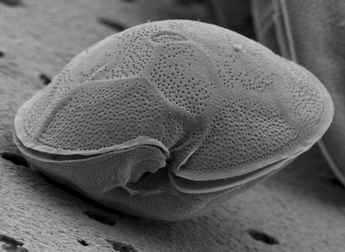
Food Safety Focus (51st Issue, October 2010) – Incident in Focus
Ciguatera Fish Poisoning
Reported by Mr. Arthur YAU, Scientific Officer,
Risk Assessment Section, Centre for Food Safety
The Centre for Health Protection (CHP) recently investigated two suspected ciguatera fish poisoning (CFP) outbreaks affecting a total of ten persons in September 2010. They developed symptoms of CFP after consumption of tiger grouper, a type of coral reef fish. None of them required hospitalisation. This article discusses what CFP is and its effect and prevention.

Marine plankton Gambierdiscus toxicus can produce ciguatera toxins (Image taken by Dr. Maria A. Faust, Department of Botany, National Museum of Natural History, Smithsonian Institution, Washington D.C., U.S.A.)
What are Ciguatera Fish Poisoning and Ciguatoxins?
CFP was first recorded in 1511 in the West Indies. CFP is endemic in many areas, including tropical and subtropical Pacific, where many of the locally-sold live coral reef fish are sourced. It is caused by the consumption of coral reef fish that contain ciguatoxins. The toxins accumulate up the food chain which starts with the herbivorous fish that graze on toxic marine planktons in the coral reef and accumulate successively in the body of larger carnivorous fish.
Ciguatoxins are a group of heat-stable, fat-soluble compounds. They are produced by marine plankton Gambierdiscus toxicus. The plankton live in the oceans between 32°N and 32°S and ciguatera fish are confined to patches of oceans in the area. The toxins are up to 50 - 100 times more concentrated in the viscera, liver and gonads of affected fish, while the fish remain asymptomatic. As the toxins are heat-stable and cannot be removed by cooking or processing, they can affect the nerve and muscle functions of persons who consume ciguatera fish. CFP is now a common type of marine food poisoning worldwide, due to increased international commerce in seafood.
Effects on Humans
The first symptoms can appear as quickly as 30 minutes, while a delay of 24 to 48 hours after consumption of CFP fish is common. The initial symptoms can be gastrointestinal or neurological. The gastrointestinal symptoms like vomiting, diarrhoea, nausea and abdominal pain usually last only a few days, the neurological symptoms like tingling of lips, hands and feet, skin itching, change in temperature perception, fatigue, muscle and joint pain appear later and last longer, sometimes up to a few years. In severe cases, low blood pressure, slow heart rate, respiratory difficulties and paralysis are possible, but death is uncommon.
Factors like previous CFP intoxication, the consumption of alcoholic beverages, nuts and seed products can also increase the sensitivity of an individual against CFP intoxication.
Local Situation
When there are notifications of CFP cases, the Centre for Food Safety (CFS) will investigate the relevant premises and suppliers in order to ascertain the species and source of implicated fish. Investigations and surveillance are difficult because food remnants are often unavailable, and traceability records are incomplete as the registration and record-keeping is currently voluntary. According to CHP, there are 32 confirmed cases of CFP affecting 102 persons between 2007 and 2009. CFS investigations showed that of all the species implicated in CFP, the most frequent were s quaretail coral grouper, lyretail, brown marbled (tiger) grouper and leopard coral grouper; the other species involved were orange spotted grouper, humphead wrasse, two-spot red snapper, moray eel, etc. CFS investigations with the trade also suggested that the mos t frequently contaminated fishing grounds were Nansha Island , Kiribati and Hainan Island . Size of fish involved usually ranged from 0.6 – 3 kg (1 – 5 catties), but fish outside this weight range had also been reported. The above information on species and source of fish may be biased as the information could not be verified.
Upon enactment of the Food Safety Bill, food traders will be required to keep relevant transaction records (acquisition records, supply records or capture records as appropriate). Therefore, it is envisaged that data collected in the future would be able to provide more accurate information on fish species and their sources.
To protect public health, the CFS has issued a Code of Practice on Import and Sale of Live Marine Fish for Human Consumption for Prevention and Control of Ciguatera Fish Poisoning which contains the minimum requirements in importing and selling live marine fish for human consumption to ensure food safety. CFS also issues advisory letters and newsletter to the traders after each recent CFP incident, providing information on fish source if available.
Key Points to Note:
-
CFP is caused by ingestion of ciguatoxins in coral reef fish; cooking and processing cannot destroy the toxins.
-
Avoid nuts, beans and alcohols when consuming coral reef fish.
-
Coral reef fish should be sourced from safe sources.
Advice to Consumers
- Eat less coral reef fish and avoid eating the roe, liver, guts, head and skin.
- Avoid nut or seed products and alcoholic beverages when consuming coral reef fish.
- Buy fish from reliable seafood retailers.
- Seek immediate medical advice if one has CFP symptoms.
Advice to the Trade
- Comply with the requirements of Code of Practice in the above for the import and sale of live marine fish for human consumption.
- Avoid sourc ing fish from areas that are known to produce ciguatoxic fish recently.
More Information
- CFS pamphlet Mind Ciguatera Fish Poisoning

